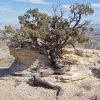coyote
In his Navajo detective novels, Tony Hillerman refers to both the regular dog-like wild animal found throughout the contiguous American continents and to Coyote, the trickster figure in Navajo cosmologies, for which the animal and its anthropomorphized character is the inspiration.
In Navajo mythology, Coyote (or First Coyote) is a trickster or troublemaker. He is often referred to as First Angry or First Scolder and is said to have brought witchcraft into the world. He appears in many stories both as a trickster who cannot be trusted and as a sexual being who tricks others in order to get his way. He is a main character of the Navajo creation story.










